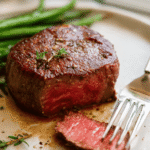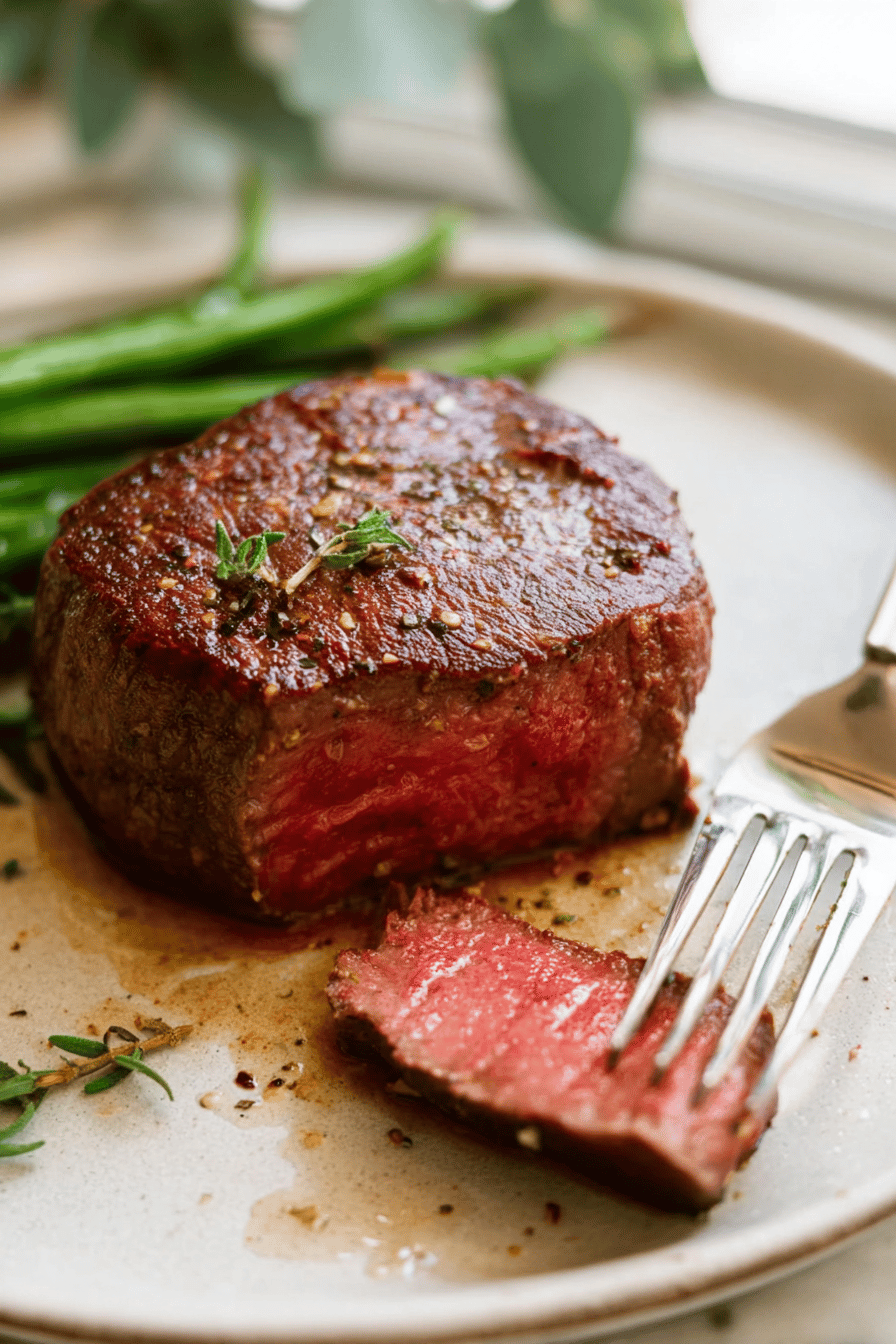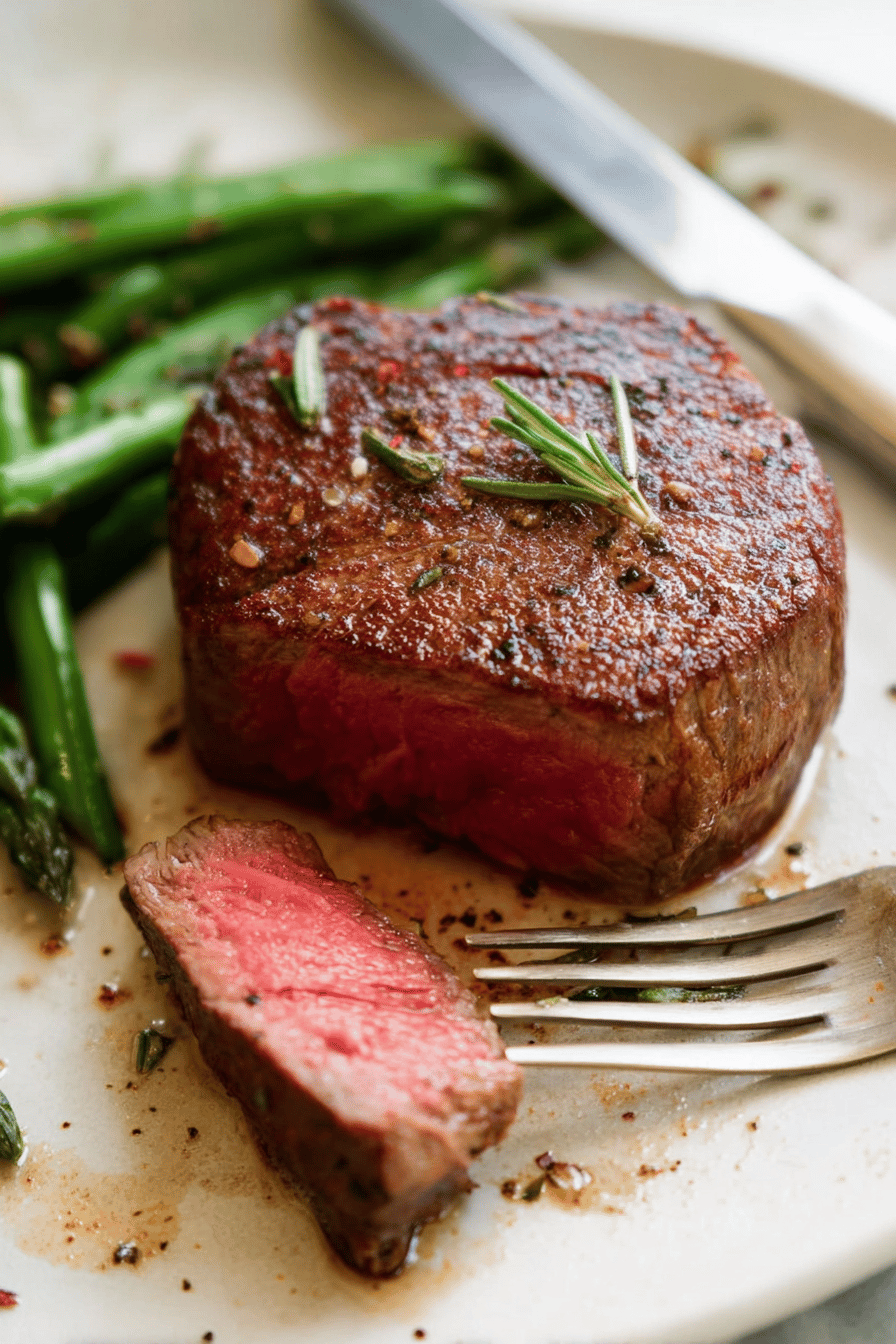Why You’ll Love This Filet Mignon
Filet mignon is a tender cut of beef taken from the smaller end of the tenderloin, offering a lean and fine-grained texture that makes it a favorite among home cooks and food enthusiasts. Its mild flavor benefits from simple enhancements like bacon wraps or sauces, while its quick cooking method suits busy lifestyles. This cut stands out for its tenderness and health benefits, making it ideal for various meals.
One key appeal lies in its ease of preparation, allowing for a restaurant-quality dish with minimal effort, perfect for weeknights or casual gatherings. The recipe uses lean cuts that provide essential nutrients like protein and vitamins, supporting overall wellness and muscle health without heavy fats. Additionally, its versatility means it adapts to different diets, from gluten-free to high-protein options, ensuring everyone can enjoy this delicacy. Due to its limited yield from each animal, filet mignon is an expensive cut, but its rich, buttery taste justifies the investment for special occasions.
Another draw is how it combines simplicity with distinctive flavor, achieved through basic seasoning that locks in juices and aroma. For those new to cooking steak, this cut requires no advanced skills, yet delivers impressive results. Consider pairing it with complementary sides to elevate everyday dinners, as recommended in resources like our guide to slow-cooked steak recipes for added inspiration.
Health and Dietary Benefits
The lean nature of filet mignon makes it a nutritious choice, packed with proteins that aid in muscle repair and overall health. Unlike fattier cuts, it contains fewer calories, appealing to diet-conscious individuals seeking flavorful yet balanced meals. This cut’s mild taste allows for creative additions, such as herbs or vegetables, to boost nutritional value without overwhelming the palate.
Incorporating filet mignon into your routine can support various lifestyles, including those of busy parents or working professionals. Its quick cook time, often in a pan to medium-rare doneness, fits into tight schedules while providing satisfaction. External sources, such as discover the surprising health benefits of eating fillet steak, highlight how it contributes to a well-rounded diet.
Jump To
- 1. Why You’ll Love This Filet Mignon
- 2. Essential Ingredients for Filet Mignon
- 3. How to Prepare the Perfect Filet Mignon: Step-by-Step Guide
- 4. Dietary Substitutions to Customize Your Filet Mignon
- 5. Mastering Filet Mignon: Advanced Tips and Variations
- 6. How to Store Filet Mignon: Best Practices
- 7. FAQs: Frequently Asked Questions About Filet Mignon
- 8. Filet Mignon
Essential Ingredients for Filet Mignon
Selecting the right ingredients is crucial for preparing filet mignon, as they enhance its natural tenderness and mild flavor. This section outlines the main components needed, ensuring a straightforward approach to creating a delicious meal. Remember to use fresh, high-quality items to achieve the best results, given that filet mignon is a lean cut typically cooked in a pan and served medium-rare.
Main Ingredients
- 2 filet mignon steaks (6 oz each) – provides the lean, tender beef that is the star of the dish.
- 2 tablespoons olive oil – for searing and adding healthy fats.
- 2 cloves garlic, minced – enhances flavor with aromatic notes.
- 1 teaspoon fresh rosemary, chopped – adds herbaceous freshness.
- Salt and pepper to taste – essential seasonings to bring out natural flavors.
Special Dietary Options
- For vegan diets: Use portobello mushroom caps or seitan as plant-based substitutes to maintain a tender texture.
- For gluten-free needs: Ensure all sauces and seasonings are gluten-free certified to avoid any issues.
- For low-calorie variations: Opt for cooking spray instead of oil and use fresh herbs as low-calorie toppings.
This structured list covers every ingredient mentioned, with precise measurements for clarity. Filet mignon’s limited yield makes it an expensive choice, so precise quantities help minimize waste while enhancing its mild flavor through simple additions like garlic and rosemary.
How to Prepare the Perfect Filet Mignon: Step-by-Step Guide
Preparing filet mignon involves a few key steps that ensure it remains tender and flavorful, leveraging its status as a lean cut from the tenderloin. Typically cooked in a pan to medium-rare, this method preserves its juices and mild taste, making it accessible for all skill levels. Below is a detailed guide to achieve optimal results.
Initial Preparation
First, remove steaks from the refrigerator 30 minutes before cooking to let them reach room temperature, which promotes even cooking and enhances tenderness. Preheat your skillet over medium-high heat and season the steak generously with salt, pepper, and preferred herbs to build a flavorful base. This step is vital as filet mignon’s mild flavor benefits from such enhancements.
Cooking Process
Add olive oil to the pan and sear the steaks for 3-4 minutes per side until a golden crust forms, locking in the meat’s natural juices. Reduce heat to medium, then incorporate minced garlic and rosemary, basting the steaks with pan juices for another 2 minutes to infuse extra flavor. For desired doneness, transfer to a preheated oven at 400°F (204°C) for 5-7 minutes, adjusting based on thickness; aim for medium-rare as it’s commonly recommended for this cut.
Finishing Touches
Rest the filet mignon for 5 minutes before serving to retain its juices, resulting in a more succulent texture. Often, it’s garnished with sauce or wrapped in bacon to enhance its mild taste, as filet mignon is lean and tender. For additional ideas, check out our recipe for garlic butter steak dishes that complement this preparation style.
External resources like roasted beef tenderloin recipe can provide further inspiration for variations. Due to its expense, precise timing helps maximize quality.
| Step | Action | Time Estimate |
|---|---|---|
| 1 | Bring steaks to room temperature | 30 minutes |
| 2 | Sear in pan | 3-4 minutes per side |
| 3 | Baste and oven finish | 5-7 minutes |
| 4 | Rest before serving | 5 minutes |
Dietary Substitutions to Customize Your Filet Mignon
Adapting filet mignon for different dietary needs is straightforward, given its lean and tender nature. As an expensive cut with a mild taste, substitutions help make it accessible to various audiences, like busy parents or seniors. Options include swapping ingredients to fit vegan, gluten-free, or low-calorie preferences.
Protein Alternatives
- Replace beef with grilled chicken breast for a lighter option.
- Use pork tenderloin as another animal-based substitute.
- Opt for tofu steaks in plant-based versions.
Other Modifications
Substitute mushroom sauce with a gluten-free gravy or tomato-based option to cater to restrictions. Adjust seasonings like rosemary for thyme based on availability, and reduce salt for low-sodium diets.
Mastering Filet Mignon: Advanced Tips and Variations
To master filet mignon, use techniques like a meat thermometer for precise doneness, enhancing its tender texture from the tenderloin. Experiment with flavors such as dry rubs or herb butters, as this cut is often prepared with additions to boost its mild taste. Presentation matters too, with elegant garnishes making it visually appealing.
Pro Techniques
Achieve even cooking through reverse searing, ideal for this expensive, lean cut.
How to Store Filet Mignon: Best Practices
Proper storage maintains filet mignon’s tenderness and flavor, preventing waste of this costly cut. Refrigerate cooked steaks in airtight containers for up to 3-4 days to keep them fresh.

FAQs: Frequently Asked Questions About Filet Mignon
What is filet mignon and why is it so tender?
Filet mignon is a cut of beef taken from the smaller end of the tenderloin, a muscle that does very little work. Because of this minimal movement, the meat is extremely tender and fine-grained. It has less fat and connective tissue than other cuts, resulting in a melt-in-your-mouth texture highly sought after by steak lovers.
How do I cook filet mignon to get the perfect medium-rare?
To achieve a perfect medium-rare filet mignon, season the steak with salt and pepper and sear it in a hot pan with a little oil for about 2-3 minutes per side. Then finish cooking in a preheated oven at 400°F (204°C) for around 5-7 minutes, or until an internal temperature of 130-135°F (54-57°C) is reached. Let it rest for 5 minutes before serving to allow juices to redistribute.
What are the best side dishes to serve with filet mignon?
Classic side dishes for filet mignon include garlic mashed potatoes, roasted asparagus, sautéed mushrooms, and a fresh green salad. These options complement the richness of the steak without overpowering its delicate flavor. Creamy sauces like béarnaise or red wine reduction also pair nicely for added depth.
How much does filet mignon typically cost per pound?
Filet mignon is one of the more expensive steak cuts, often priced between $25 to $40 per pound, depending on quality, grade, and regional availability. Prices can vary more for organic or grass-fed options. Because it is a smaller, premium cut, cooking in smaller portions is common.
Can I freeze filet mignon without losing quality?
Yes, you can freeze filet mignon to preserve freshness. Wrap the steak tightly in plastic wrap, then place it in a freezer bag or vacuum-seal it to prevent freezer burn. For best quality, use within 6 months. Thaw it slowly in the refrigerator before cooking to maintain texture and flavor.

Filet Mignon
- Total Time: 15 minutes
- Yield: 2 servings
- Diet: Gluten-Free
Description
🥩 Filet mignon recipes offer a tender and lean cut of beef that delivers rich, flavorful steaks perfect for special occasions.
🔥 Cooking tips help achieve the ideal medium-rare doneness, preserving its delicate texture and mild taste.
Ingredients
– 2 filet mignon steaks (6 oz each) provides the lean, tender beef that is the star of the dish
– 2 tablespoons olive oil for searing and adding healthy fats
– 2 cloves garlic, minced enhances flavor with aromatic notes
– 1 teaspoon fresh rosemary, chopped adds herbaceous freshness
– Salt and pepper to taste essential seasonings to bring out natural flavors
Instructions
Initial Preparation: First, remove steaks from the refrigerator 30 minutes before cooking to let them reach room temperature, which promotes even cooking and enhances tenderness. Preheat your skillet over medium-high heat and season the steak generously with salt, pepper, and preferred herbs to build a flavorful base. This step is vital as filet mignon’s mild flavor benefits from such enhancements.
Cooking Process: Add olive oil to the pan and sear the steaks for 3-4 minutes per side until a golden crust forms, locking in the meat’s natural juices. Reduce heat to medium, then incorporate minced garlic and rosemary, basting the steaks with pan juices for another 2 minutes to infuse extra flavor. For desired doneness, transfer to a preheated oven at 400°F (204°C) for 5-7 minutes, adjusting based on thickness; aim for medium-rare as it’s commonly recommended for this cut.
Finishing Touches: Rest the filet mignon for 5 minutes before serving to retain its juices, resulting in a more succulent texture. Often, it’s garnished with sauce or wrapped in bacon to enhance its mild taste, as filet mignon is lean and tender. For additional ideas, check out our recipe for garlic butter steak dishes that complement this preparation style.
Notes
🔥 Use a meat thermometer to avoid overcooking and ensure perfect medium-rare steaks.
🥓 Wrapping steaks in bacon adds flavor and moisture.
🍷 Prepare a complementary sauce like red wine reduction to enhance the mild flavor of filet mignon.
- Cook Time: 8 minutes
- Category: Main Dish
- Method: Pan-searing
- Cuisine: American
Nutrition
- Serving Size: 1 steak
Keywords: filet mignon, tender steak, flavorful steaks, cooking tips


